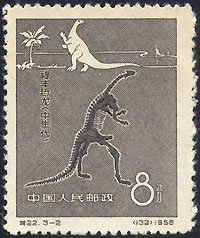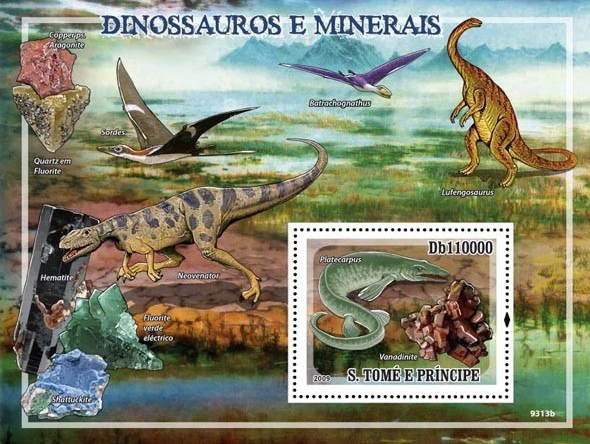Lufengosaurus huenei Young, 1941

Phylum: Chordata Haeckel, 1874
Subphylum: Vertebrata Cuvier, 1812
Classe: Dinosauria Owen, 1841
Ordine: Saurischia Seeley, 1887
Famiglia: Massospondylidae Huene, 1914
Genere: Lufengosaurus Young C.C. , 1941
Specie e sottospecie
Il genere annovera ttualmente le seguenti specie: Lufengosaurus huenei Young, 1940 (specie tipo) - Lufengosaurus magnus Young, 1947.
Descrizione
Scoperto nel 1941 nello Yunnan, questo dinosauro è stato ritenuto subito simile al famoso Plateosaurus europeo. Il nome specifico, L. huenei, è stato scelto apposta per onorare Friedrich von Huene, che studiò in dettaglio gli esemplari europei. Il lufengosauro, però, è stato poi avvicinato ad altre forme, come Massospondylus del Sudafrica. La forma cinese è conosciuta per numerosissimi individui di ogni età, e ciò ha permesso di scoprire dettagliatamente l'anatomia scheletrica di questo animale: il lufengosauro era lungo circa sei metri, fornito di un collo lungo e di una testa fornita di una sorta di becco dentato. Il corpo pesante era bilanciato da una lunga coda e, come tutti i prosauropodi, le zampe erano fornite di potenti artigli.
Diffusione
Vissuto in Cina nel Giurassico inferiore.
Bibliografia
–"Lufengosaurus." In: Dodson, Peter & Britt, Brooks & Carpenter, Kenneth & Forster, Catherine A. & Gillette, David D. & Norell, Mark A. & Olshevsky, George & Parrish, J. Michael & Weishampel, David B. The Age of Dinosaurs. Publications International, LTD. p. 38.
–Young, C.-C. 1940. "Preliminary notes on the Lufeng vertebrate fossils". Bulletin of the Geological Society of China 20(3-4): 235-239.
–Young, C. C. (1941). "A Complete Osteology of Lufengosaurus huenei Young (gen. et. sp. nov.) from Lufeng, Yunnan, China". Palaeontologica Sinica. 7: 1-53.
–Barret, P. M.; Upchurch, P.; Wang, X. L. (2005). "Cranial osteology of Lufengosaurus huenei Young (Dinosauria: Prosauropoda) from the Lower Jurassic of Yunnan, People's Republic of China". Journal of Vertebrate Paleontology. 25 (4): 806-822.
–Galton, P.M. (1976). "Prosauropod dinosaurs (Reptilia: Saurischia) of North America". Postilla. 169: 1-98.
–Wang, Y.M.; You, H.L.; Otero, A.; Wang, T. (August 23-26, 2017). "Taxonomy of "Gyposaurus" sinesis Young, 1941 from the Early Jurassic Lufeng Formation of Yunnan Province, southwestern China". SVP 2017 Meeting Program and Abstracts. Society of Vertebrate Paleontology 77th Annual Meeting. Calgary: Society of Vertebrate Paleontology. p. 210.
–Cooper M. (1981) "The prosauropod dinosaur Massospondylus carinatus Owen from Zimbabwe: its biology, mode of life and phylogenetic significance". Occasional Papers Of The National Museums and Monuments of Rhodesia Series B Natural Sciences 6(10): 689-840.
–Zhao X., 1985, "The Jurassic Reptilia". In: Wang, Cheng and Wang (eds.). The Jurassic System of China. Stratigraphy of China, Volume 11. pp. 286-289.
–Lee, Yao-Chang; Chiang, Cheng-Cheng; Huang, Pei-Yu; Chung, Chao-Yu; Huang, Timothy D.; Wang, Chun-Chieh; Chen, Ching-Iue; Chang, Rong-Seng; Liao, Cheng-Hao; Reisz, Robert R. (31 January 2017). "Evidence of preserved collagen in an Early Jurassic sauropodomorph dinosaur revealed by synchrotron FTIR microspectroscopy". Nature Communications. 8 (1): 14220.
–Paul, G.S., 2010, The Princeton Field Guide to Dinosaurs, Princeton University Press p. 135.
–Benson, Roger B. J.; Campione, Nicolás E.; Carrano, Matthew T.; Mannion, Philip D.; Sullivan, Corwin; Upchurch, Paul; Evans, David C. (2014-05-06). "Rates of Dinosaur Body Mass Evolution Indicate 170 Million Years of Sustained Ecological Innovation on the Avian Stem Lineage". PLOS Biology. 12 (5): e1001853.
–Benton, Michael J. (2012). Prehistoric Life. Edinburgh, Scotland: Dorling Kindersley. p. 265.
–Sekiya, T. & Dong, Z. 2010. "A New Juvenile Specimen of Lufengosaurus huenei Young, 1941 (Dinosauria: Prosauropoda) from the Lower Jurassic Lower Lufeng Formation of Yunnan, Southwest China". Acta Geologica Sinica 84 (1): 11-21.
–Novas, Fernando E.; Martin D. Ezcurra; Sankar Chatterjee; T. S. Kutty (2011). "New dinosaur species from the Upper Triassic Upper Maleri and Lower Dharmaram formations of central India". Earth and Environmental Science Transactions of the Royal Society of Edinburgh. 101 (3-4): 333-349.
–Rauhut, O. W. M.; Holwerda, F. M.; Furrer, H. (2020). "A derived sauropodiform dinosaur and other sauropodomorph material from the Late Triassic of Canton Schaffhausen, Switzerland". Swiss Journal of Geosciences. 113 (1): 8.
–Reisz, Robert R.; Huang, Timothy D.; Roberts, Eric M.; Peng, Shinrung; Sullivan, Corwin; Stein, Koen; Leblanc, Aaron R. H.; Shieh, Darbin; Chang, Rongseng; Chiang, Chengcheng; Yang, Chuanwei; Zhong, Shiming (2013). "Embryology of Early Jurassic dinosaur from China with evidence of preserved organic remains" (PDF). Nature. 496 (7444): 210-214.
–Reisz, R. R.; Huang, T. D.; Chen, C.-M.; Tu, S.-J.; Tsai, T.-C.; Zhong, SM.; Mooney, E. D.; Bevitt, J. J. (2024). "Parental feeding in the dinosaur Lufengosaurus revealed through multidisciplinary comparisons with altricial and precocious birds". Scientific Reports. 14 (1). 20309.

|
Data: 15/04/1958
Emissione: La paleontologia in Cina Stato: China (P.R.C.) |
|---|

|
Data: 29/05/2009
Emissione: Dinosauri e minerali Stato: St. Thomas and Prince |
|---|